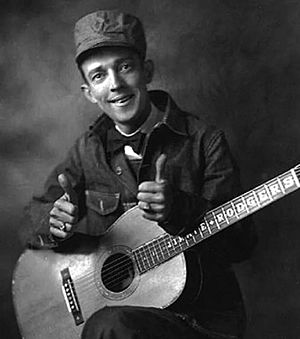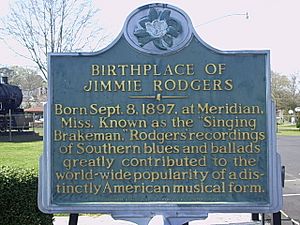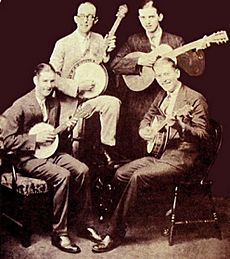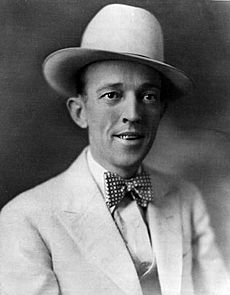Jimmie Rodgers (country singer) facts for kids
Quick facts for kids
Jimmie Rodgers
|
|
|---|---|

Rodgers in 1931
|
|
| Background information | |
| Birth name | James Charles Rodgers |
| Born | September 8, 1897 Meridian, Mississippi, U.S. |
| Died | May 26, 1933 (aged 35) New York City, New York, U.S. |
| Genres | Country, blues, folk |
| Occupation(s) |
|
| Instruments | Vocals, acoustic guitar, tenor banjo |
| Years active | 1910–1933 |
| Labels | Victor |
| Associated acts | The Tenneva Ramblers, The Ramblers, Louis Armstrong, Will Rogers |
James Charles Rodgers (September 8, 1897 – May 26, 1933) was an American singer and songwriter. He became very popular in the late 1920s. Many people call him "the Father of Country Music." He was best known for his unique rhythmic yodeling.
Unlike many stars back then, Rodgers became famous mostly through his recordings. These were some of the first country music records ever made. He later performed concerts that were also very popular. He inspired many artists in both country music and the blues. He was also known as "The Singing Brakeman" and "The Blue Yodeler."

Contents
Jimmie Rodgers' Early Life
Jimmie Rodgers was born on September 8, 1897. He is usually said to be from Meridian, Mississippi. However, some papers he signed later listed his birthplace as Geiger, Alabama. Historians believe he was truly born in Pine Springs, Mississippi, near Meridian.
Jimmie's mother passed away when he was about six or seven years old. He was the youngest of three sons. For a few years, he lived with different relatives. He later returned home to live with his father, Aaron Rodgers. His father worked on the railroad in Meridian.
Jimmie Rodgers' Music Career
Starting His Music Journey
Jimmie loved to entertain from a young age. He tried to start traveling shows twice by age 13. His father always brought him home. His first job was working on the railroad as a water boy. Here, railroad workers and hobos taught him how to play the guitar. He also heard the work songs of African-American railroad workers.
Later, he became a brakeman on a railroad line. This job was once held by his older brother.
In 1924, when he was 27, Rodgers became sick with tuberculosis. This illness stopped his railroad career for a while. But it also gave him a chance to get back into entertainment. He started a traveling show and performed across the southeastern United States. He had to stop when a storm destroyed his tent.
He went back to railroad work in Miami, Florida. But his illness made him lose that job too. He moved to Tucson, Arizona, and worked for the Southern Pacific Railroad. He kept that job for less than a year. By early 1927, Jimmie, his wife Carrie, and daughter Anita moved back to Meridian.
Finding Success in Music
In 1927, Rodgers traveled to Asheville, North Carolina. On April 18, 1927, he performed on WWNC, Asheville's first radio station. A few months later, he formed a group called the Tenneva Ramblers. They got a weekly spot on the radio as "The Jimmie Rodgers Entertainers."
In July 1927, Rodgers' band heard about Ralph Peer. Peer worked for the Victor Talking Machine Company. He was coming to Bristol, Tennessee, to find new musicians. These auditions became famous as the Bristol sessions. Rodgers and his group went to Bristol on August 3, 1927. They auditioned for Peer in an empty warehouse.
Peer agreed to record them the next day. But the band argued about how they would be named on the record. The band broke up. Rodgers went to the recording session alone on August 4. He recorded two songs: "The Soldier's Sweetheart" and "Sleep, Baby, Sleep." He earned $100 for these first recordings.
The songs were released in October and did fairly well. Rodgers was determined to succeed. In November, he went to New York City to record more songs with Peer. He asked his sister-in-law, Elsie McWilliams, to help him write songs. She became his main songwriting partner. She helped write almost 40 songs for him.
Rodgers went to the Victor studios in Camden, New Jersey. He recorded four more songs, including "Blue Yodel." This song was also known as "T for Texas." Rodgers said he learned the yodel from a group of Swiss performers. In the next two years, this song sold nearly half a million copies. This made Rodgers a huge star. After this, he decided when and where Victor would record him. His shows were always sold out.
For the next few years, Rodgers was very busy. He made a short movie for Columbia Pictures called The Singing Brakeman. He also made many recordings across the country. He performed with humorist Will Rogers on a Red Cross tour.
On July 16, 1930, he recorded "Blue Yodel No. 9." Louis Armstrong played the trumpet, and Armstrong's wife Lil played the piano.
Later Years and Legacy
Rodgers' last recordings were made in August 1932. His tuberculosis was getting worse. He had stopped touring by then. He had a weekly radio show in San Antonio, Texas. He had moved there after "T for Texas" became a hit. But Rodgers couldn't stay still. His constant touring and recording made his health worse.
In May 1933, Rodgers traveled to New York City for more recording sessions. He started recording alone on May 17. He finished four songs that day. When he returned to the studio, he had to record sitting down. He went back to his hotel to rest. The recording engineer hired two musicians to help him a few days later. They recorded songs like "Mississippi Delta Blues." For his very last song, Rodgers chose to perform alone. He recorded "Years Ago."
During this final session, Rodgers was very weak from tuberculosis. A nurse was with him on May 24. He had to rest on a cot between songs. He passed away from tuberculosis in a New York hotel two days later. He was 35 years old. His body was sent back to Meridian, Mississippi. He was buried in Oak Grove Cemetery.
Jimmie Rodgers' Personal Life
Rodgers married Carrie Cecil Williamson (1902–1961). They had two daughters. Carrie Anita Rodgers (1921–1993) was known as Anita. Their second daughter, June Rebecca Rodgers, passed away at six months old in 1923.
With the money he earned from his recordings, Rodgers built his "dreamhouse" for his family. It was in Kerrville, Texas. He chose this place partly for health reasons.
Rodgers was known for being friendly and upbeat. He stayed friends with his old pals and bandmates. When he was on tour, he was famous for being kind to strangers. He often gave free performances and talked with his fans.
He passed away on May 26, 1933, from a lung bleed caused by tuberculosis. He was 35 years old. At that time, his music made up 10% of RCA Victor's sales.
Jimmie Rodgers' Lasting Impact
When the Country Music Hall of Fame and Museum started in 1961, Rodgers was one of the first people honored. He was also elected to the Songwriters Hall of Fame in 1970. In 1986, he was inducted into the Rock and Roll Hall of Fame as an early influence. His song "Blue Yodel No. 9" was chosen as one of the Rock and Roll Hall of Fame's 500 Songs that Shaped Rock and Roll. In 2003, CMT ranked him No. 33 on their list of the 40 Greatest Men of Country Music.
Since 1953, the Jimmie Rodgers Memorial Festival has been held every May in Meridian, Mississippi. It honors the anniversary of his death.
A song called "Chemirocha III" was collected in 1950 from the Kipsigis people in Africa. This song was written to honor Jimmie Rodgers. The song's title sounds like his name. The tribe members heard Rodgers' music from British soldiers during World War II. They were amazed by his yodeling. They imagined Rodgers as a magical creature, half-man and half-antelope.
Many famous musicians were influenced by Jimmie Rodgers. These include Gene Autry, Jimmie Davis, Merle Haggard, Hank Snow, and Lefty Frizzell. Ernest Tubb loved Rodgers and started every episode of his radio show with a Rodgers song. This tradition continues today.
Lynyrd Skynyrd covered Rodgers' "Blue Yodel No. 1 (T for Texas)." Their lead singer, Ronnie Van Zant, said they loved old country music like Jimmie Rodgers. They even mentioned Rodgers in their song "Railroad Song."
Rodgers' "T for Texas" was also featured in The Beatles Anthology documentary. George Harrison said Jimmie was one of his early influences.
In 1997, Bob Dylan put together a tribute album called The Songs of Jimmie Rodgers, A Tribute. It featured artists like Bono, Alison Krauss, Jerry Garcia, and Willie Nelson. Dylan said Rodgers' songs were unique and powerful.
In 2004, fellow Meridian native Steve Forbert's tribute album to Jimmie Rodgers, Any Old Time, was nominated for a Grammy Award.
On May 24, 1978, the United States Postal Service released a stamp honoring Rodgers. It was the first in their Performing Arts Series. The stamp showed Rodgers in his brakeman's outfit with a guitar.
Rodgers was not just a country artist. He was one of the biggest stars in American music between 1927 and 1933. He helped make blues music popular more than almost anyone else at that time. The book Meeting Jimmie Rodgers shows his influence across many music styles. He influenced blues artists like Muddy Waters, Big Bill Broonzy, and Howlin' Wolf. Howlin' Wolf said Rodgers was his childhood hero. When he tried to yodel like Rodgers, it sounded more like a growl or a howl. He said, "I couldn't do no yodelin', so I turned to howlin'. And it's done me just fine."
Elvis Presley said Rodgers was an important influence on him. Jerry Lee Lewis also covered several of his songs. Johnny Cash said the first record he ever heard was by Jimmie Rodgers. He even tried to yodel like Rodgers in a song.
The 1982 movie Honkytonk Man, starring Clint Eastwood, was loosely based on Rodgers' life.
On May 3, 2007, Rodgers was honored with a marker on the Mississippi Blues Trail in Meridian. In May 2010, a marker on the Mississippi Country Music Trail was placed near his grave. In 2013, Rodgers was added to the Blues Hall of Fame.
Jimmie Rodgers' Recordings
The Jimmy Rodgers' Story - complete recordings RCA JAPAN RA-5459-66
See also
 In Spanish: Jimmie Rodgers para niños
In Spanish: Jimmie Rodgers para niños




